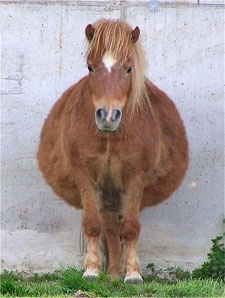
Buckley, Morton, Buckley and Coleman of the Australian Charles Sturt University conducted research about horse misbehaviour as an important cause of poor performance in Pony Club horses. The research team concluded that fat ponies misbehave more than fit ones.
Misbehaviour is associated with horse-related rider injuries and has been implicated as a nonspecific presenting sign for musculoskeletal pain. Despite this, little is known about the incidence of and risk factors for misbehaviour in Pony Club horses.
A prospective longitudinal study was conducted with 84 Pony Club horses from 41 families belonging to 7 Pony Clubs in one inland region of Australia. Horse behaviour is related to horse temperament, and parents with children who ride at Pony Club rated temperament more highly than soundness when choosing a suitable horse for their children
Owners recorded misbehaviour events and kept daily records of horse housing, exercise, nutrition, healthcare and disease status. Horses were subjected to a monthly veterinary examination. Descriptive statistics were calculated to describe the incidence of misbehaviour, and multivariable logistic regression was used to assess putative risk factors.
Misbehaviour during riding occurred on 3% of days when horses were ridden. On 52% of days with misbehaviour, the misbehaviour was classified as dangerous. Risk of misbehaviour was independently increased on exercise days when the horse was competing, and in months when the horse was fat or obese, fed supplementary feed daily, grazed on paddocks with >50% of ground cover as green grass, exercised on 5 days per month or less, and ridden for a total of 12 h or more in the month. No significant relationship was detected between misbehaviour and back pain.
Misbehaviour was more likely when horses were competing, a period when they are subjected to greater mental and physical challenges than during leisure riding. Mental challenges for the horse while competing may be associated with factors such as horse–rider mismatch, rider tension and horse temperament, and could adversely affect horse behaviour. Furthermore, unrealistic expectations during competition may lower the rider’s threshold for frustration, giving rise to horse–rider conflict and, consequently, to misbehaviour. It is also possible that the threshold for rider perception of misbehaviour during stressful situations, such as competition, is also lower. Potential explanations for the observed increased risk of misbehaviour with 12 or more hours of exercise per month are difficult to identify, particularly in light of the observed benefit of more frequent riding days, which is consistent with evidence that an accumulation of positive interactions reinforces the development of a positive relationship. However, this latter association may also be due to ‘reverse causation’, with children being less likely to choose to ride horses that have previously misbehaved.
In populations such as the study population the risk of misbehaviour is higher in fatter horses, in horses with access to pastures with greater green grass cover, in those fed daily supplements, in horses receiving exercise less frequently, and during competition. Odds of misbehaviour on exercise days were more than twice as high when supplements (roughage, concentrates and/or grain) were fed daily compared with feeding on 2 days per week or less.
Horse nutrition- and exercise-related factors are associated with increased risk of misbehaviour in horses during riding. In populations such as the study population the risk of misbehaviour is higher in fatter horses, in horses with access to pastures with greater green grass cover, in those fed supplements daily, in horses receiving exercise less frequently, and during competition.
The results highlight the importance of considering horse body condition, nutrition and exercise in any investigation of horse misbehaviour. Recommendations, including exercising horses at least 3 times a week and maintaining an ideal body condition score of 3 by more closely matching pasture and supplemental feed intake to horses’ energy requirements, could be used by veterinarians to assist owners of Pony Club horses to prevent misbehaviour.
The complete study can be read here.